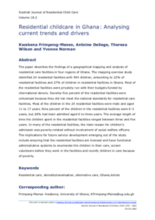Abstract
The paper describes the findings of a geographical mapping and analysis of residential care facilities in four regions of Ghana. The mapping exercise study identified 24 residential facilities with 944 children, amounting to 22% of residential facilities and 27% of children in residential facilities in Ghana. Most of the residential facilities were privately run with their budgets funded by international donors. Seventy-five percent of the residential facilities were unlicensed because they did not meet the national standards for residential care facilities. Most of the children in the 24 residential facilities were male and aged 11 to 17 years. Nine percent of the children in the residential facilities were 0-3 years, but 28% had been admitted aged 0 to three years. The average length of time the children spent in the residential facilities ranged between three and five years. In many of the residential facilities, the main reason for children’s admission was poverty-related without involvement of social welfare officers. The implications for future service development emerging out of the study include ensuring that the residential facilities are licensed and have functional administrative systems to enumerate the children in their care, screen volunteers before they work in the facilities and reunify children in care because of poverty.

